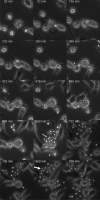Antibody action after phagocytosis promotes Cryptococcus neoformans and Cryptococcus gattii macrophage exocytosis with biofilm-like microcolony formation
- PMID: 18384661
- PMCID: PMC4294708
- DOI: 10.1111/j.1462-5822.2008.01152.x
Antibody action after phagocytosis promotes Cryptococcus neoformans and Cryptococcus gattii macrophage exocytosis with biofilm-like microcolony formation
Abstract
Antibody-mediated phagocytosis was discovered over a century ago but little is known about antibody effects in phagolysosomes. We explored the consequences of antibody-mediated phagocytosis for two closely related human pathogenic fungal species, Cryptococcus neoformans and Cryptococcus gattii, of which C. neoformans encompasses two varieties: neoformans and grubii. The interaction between C. neoformans varieties grubii and neoformans and host cells has been extensively studied, but that of C. gattii and macrophages remains largely unexplored. Like C. neoformans, antibody-mediated phagocytosis of C. gattii cells was followed by intracellular replication, host cell cytoplasmic polysaccharide accumulation and phagosomal extrusion. Both C. gattii and C. neoformans cells exited macrophages in biofilm-like microcolonies where the yeast cells were aggregated in a polysaccharide matrix that contained bound antibody. In contrast, complement-opsonized C. neoformans variety grubii cells were released from macrophages dispersed as individual cells. Hence, both antibody- and complement-mediated phagocytosis resulted in intracellular replication but the mode of opsonization affected the outcome of exocytosis. The biofilm-like microcolony exit strategy of C. neoformans and C. gattii following antibody opsonization reduced fungal cell dispersion. This finding suggests that antibody agglutination effects persist in the phagosome to entangle nascent daughter cells and this phenomenon may contribute to antibody-mediated protection.
Figures






References
-
- Alvarez M, Casadevall A. Phagosome extrusion and host-cell survival after Cryptococcus neoformans phagocytosis by macrophages. Curr Biol. 2006;16:2161–2165. - PubMed
-
- Casadevall A, Perfect J. Cryptococcus Neoformans. American Society for Microbiology Press; Washington, DC: 1998.
Publication types
MeSH terms
Substances
Grants and funding
LinkOut - more resources
Full Text Sources

